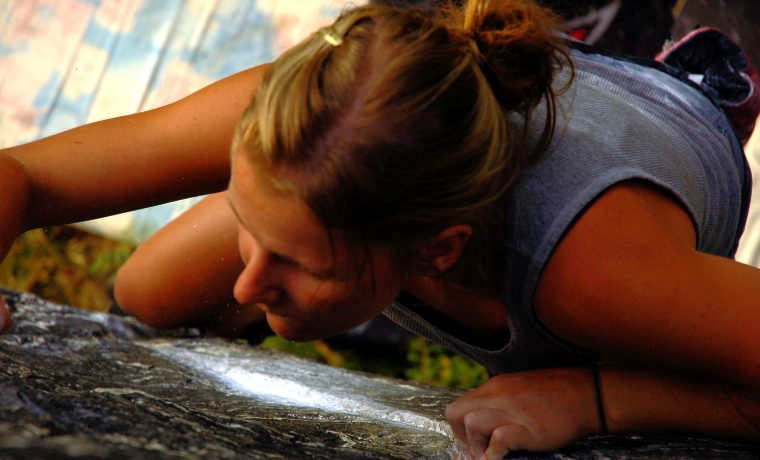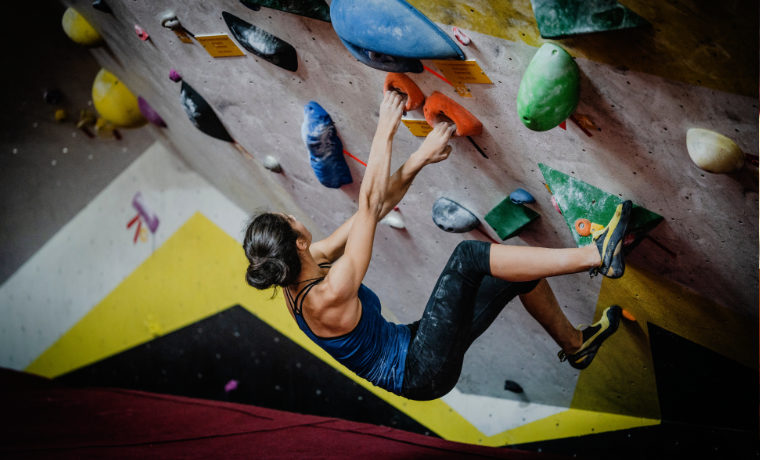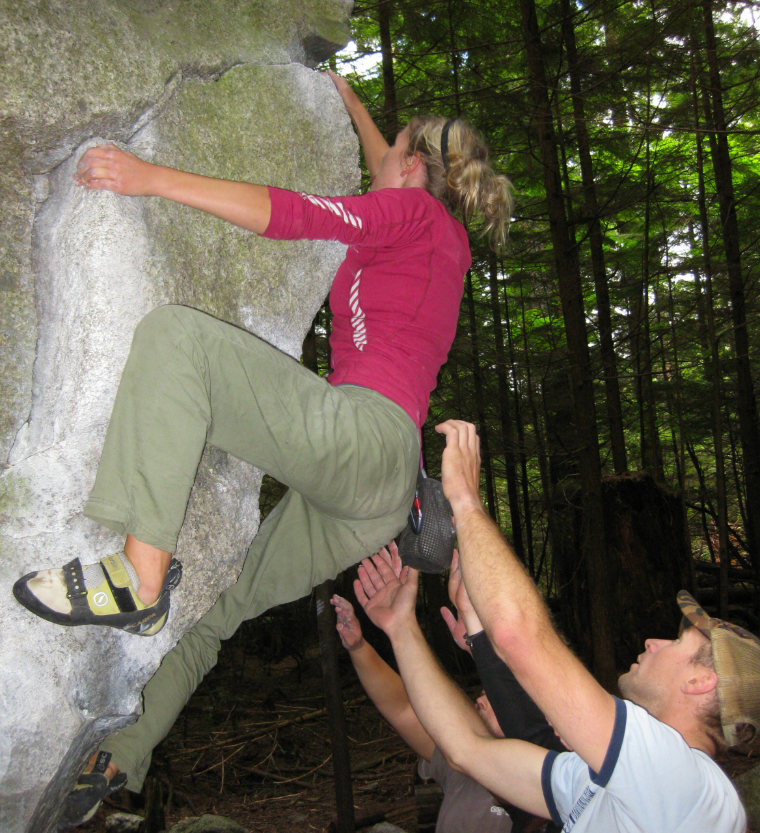If you’re new to bouldering or you’re already addicted, but wish to improve, then this article is for you. In short, it’s a list of 20 bouldering tips divided into three categories.
The first one is general bouldering tips that can be applied to indoor and outdoor bouldering, as well as other types of climbing. Most are physical tips to improve technique, but they also include mental ones to free your mind in order to boulder more efficiently. The second category is aimed at indoor bouldering, whilst the third looks at outdoor bouldering tips. As bouldering outdoors requires more know-how, this final category consists primarily of practical tips to help you stay safe and get the most out of your climbing sessions.
Many of the below tips for bouldering can also be applied to rock climbing with ropes. If you’re more into rope climbing than bouldering then you might want to head over to our article for improver rock climbers.
NOTE: There are some terms used in this article which may not make total sense to those new to the climbing word. If you find yourself wondering what “juggy holds” are or questioning whether “crimps” are something to apply to your hair, then you might find our climbing terms article useful.

General bouldering tips
01Drive up with your legs
As much as bouldering is associated with strong arms and strong fingers, the power to move upwards starts with the legs. This is especially true for beginners when climbing on less steep rock. Before you stretch your arms reaching for the next hand hold, first engage your legs and drive up to gain height.
02Look down at your feet
Looking up is important; that’s where you’re heading. But experienced boulderers spend as much if not more time looking down at their feet. The mark of a good climber is good footwork, which means keeping the maximum amount of weight on your toes, knowing where your next foothold will be before you move, then precisely placing your toe on the hold. Developing good footwork is one of the most important bouldering tips for beginners.
03Keep your body close to the wall
When climbing on vertical and overhanging rock, it’s important to keep your hips as close to the wall as possible; having a strong core will help. This will then raise your centre of gravity so that more of your weight is over your feet and you become less reliant on your arms, which tire more quickly than your legs.
04Don’t over grip
When you pick up a fork you will unconsciously grip it with less force than a heavy plate of food. The muscles in your forearm are only working as hard as they need to. This is the same for climbing with respect to large juggy holds vs small or sloping holds. But when scared, perhaps feeling that the bouldering mats are getting uncomfortably small beneath you, there is a tendency to over grip and therefore become prematurely pumped. Try to relax instead and only apply as much pressure as necessary.
05Straight arms
It is a lot easier to hang from a pull-up bar or fingerboard with arms in a straight, locked position; try doing it with bent arms and you will not last as long. The same goes for climbing. In order to gain height, start from a position of straight arms and bent legs. Then drive up with your legs, twisting your body to maintain straight arms for as long as possible before reaching for the next hand hold.
06Learn to backstep
Beginners tend to place their feet perpendicular to the wall, like climbing a ladder, or they turn their ankles inwards and use the inside of their feet. But while these positions might seem more secure, it limits movement, especially the maximum height you can reach. By twisting your hips and placing the outside of your foot closest to the wall – known as backstepping – you will be able to gain greater height.
07Balance and control
When watching very good climbers (or anyone who excels in any sport) you will invariably notice that they possess exceptional balance in motion. When they move from one position to another, they are in total control of their bodies. Practice the art of smooth climbing by staying relaxed and slowly but purposefully moving from one hold to the next.
08Continue to breathe
Breathing is useful, which should go without saying, but many inexperienced climbers hold their breath in stressful situations. This doesn’t help and exacerbates the problem by putting your body under added tension. It is therefore important to continue to breathe, to stay as calm and as controlled as possible in order to tick the problem.
09Warm up
Bouldering puts your body under significant strain and you are more likely to injure yourself if you go straight into tackling a problem at your maximum grade. It is advisable to warm up and stretch before you start climbing, especially if you’re older than you’d like to admit. And when you do pull on to the wall, begin with an easy problem, a simple traverse or even a lighthearted climbing game.
10Climb with freedom: don’t over think
You don’t need to teach children how to walk, and nor do they need to be told how to reach the top of a climbing frame. To put it another way, climbing is as natural a movement as walking. The points above will help you boulder, but so will letting your body do what it already knows how to do, letting it move freely without conscious instruction.

Indoor bouldering tips
11Be aware of other climbers
Climbing centres tend to be busy places, especially in the evenings and weekends. Once on the wall be vigilant of other climbers either on problems that pass near yours or those still on the ground and potentially within your falling zone. Don’t climb above or beneath someone else; just wait, watch, make new friends, then start when it’s safe to do so.
12Learn to downclimb
Downclimbing is an important skill to practise for indoor bouldering as climbing centres would rather you didn’t simply drop from the top hold once you’ve ticked a problem. There is more chance of injury with more people around. But don’t think of downclimbing as a chore; it will improve your footwork and it’s great for stamina.
13Get to know your local climbing wall
Climbing walls have their own particular way of doing things. Start by learning the chosen grading, whether it’s the font or V system, and then how this relates to different coloured holds. Also find out whether integrated features on the wall and aretes are allowed on certain problems. And if provided, get to know the names of the route-setters, as you might discover that problems set by one person are more suitable to your body shape and style than others.
14Mix up a session with variety
When outdoors, the crag can often have problems of one particular kind: either all slabs or all steep overhangs or all vertical walls with small crimps. But indoors you have the luxury of mixing up your climbing in one session. So if your arms tire from too many roof problems, you can simply move onto slabs.
15Take your time: the art of resting
There is a tendency for beginner boulderers to arrive at an indoor wall and go crazy, climbing problem after problem, all at their limit with no rest in between. Doing this, your arms will pump out very quickly and you’ll be back home 30 minutes later. It’s much better to take your time, to warm up slowly, to rest between climbs, even wandering off to get coffee and cake, and relax on any comfy sofas that might be available.

Outdoor bouldering tips
16Lower your expectations
If you have been bouldering indoors for some time and claim to be a confident V3 boulderer, say, you’re unlikely to be able to match that grade the first time you go outdoors. The problems tend to be higher, the landings are worse and there are no coloured holds to tell you where to go. So it’s best to start on easier problems and don’t be disappointed if it takes a little while to reach your indoor grade.
17Placing crash pads
Crash pads turn outdoor bouldering into a relatively safe activity. The more you have the greater the area you can cover (necessary for overhanging problems or ones that weave sideways) and at a greater depth (necessary for high balls). Place the pads close together to eliminate gaps, or overlap them. Also be wary of rocks, particularly sharp ones, that might need extra padding. And if the ground slopes away from the wall, try to level it with additional pads.
18The art of spotting
Spotting is an important safety feature of outdoor bouldering, and when climbing with a spotter you will feel a lot more confident on harder problems. The aim of spotting is not to catch the climber, but to make sure she doesn’t fall backwards off the pads and potentially hit her head on hard ground. Remember to keep your arms up in the air, as you won’t have time to raise them during a fall.
19Learn to top out safely
Most indoor bouldering problems end with both hands on the top hold. In contrast, most outdoor bouldering problems are only completed when you’ve topped out, that is standing on top of the boulder … or slumped in a heap if you’re less worried about style! It can feel quite scary at first, but the more you commit the easier it becomes. The key is to get your head and then as much of your body as possible over the top before bringing up your feet.
20Check the forecast: cold, but not too cold
If you boulder outdoors for long enough, especially in the UK, you will invariably become an amateur meteorologist in your search for the perfect conditions. Most non-climbers can imagine that rain and climbing do not mix, but they might not be aware that heat is as much of a nuisance to climbers as water. The rock is grippier and your hands will be less sweaty in the cold, but too cold and your muscles and joints will protest: 5-10ºC is ideal.
Now that you’ve made it to the end of the article, I can say that whilst all the above are useful bouldering tips, once you’ve internalised them, it’s best to forget them and simply enjoy the feeling of climbing. But don’t forget tip number 10! Climbing is one of the most natural ways to move your body. Don’t overthink or over analyse what you’re doing. Just climb!



